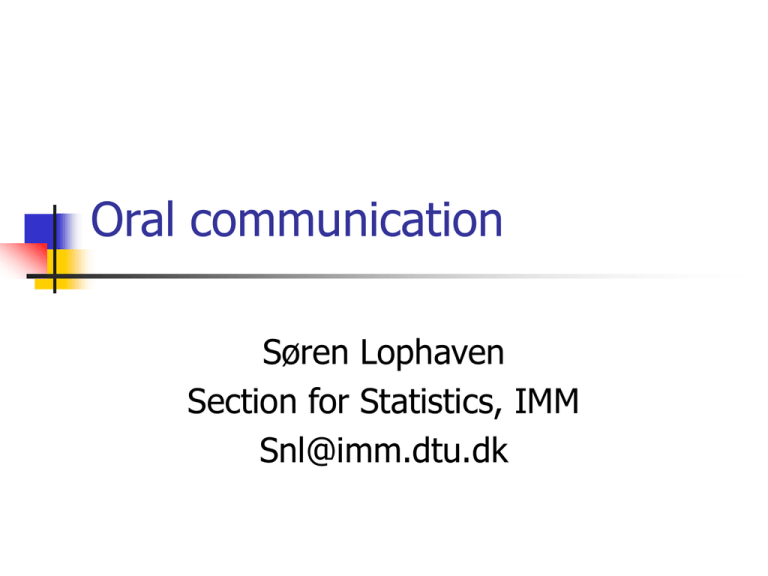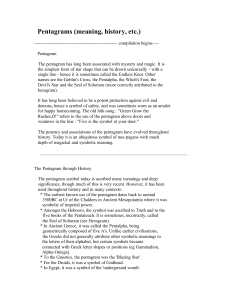Oral Presentation
advertisement

Oral communication Søren Lophaven Section for Statistics, IMM Snl@imm.dtu.dk Literature: Mundtlig Formidling Anne Katrine Lund Frydenlund Oral communication: In this context: Not just telling the audience about a specific subject. But explaining the subject in a way which makes it understandable and interesting. The pentagram The pentagram 1. Circumstances Where and why is the communication happening, and what does it aim at ? 2 and 3. Subject and audience What is the topic of the communication, and who are the listeners ? The pentagram 4.Language 5. Does the type of audience or the subject of the communication require you to use a specific language ? Speaker How to talk, how to make your self understandable. Control nervousness. Circumstances Different types of circumstances: Introduction of subject in class room Presentation of a project Answering of questions Debate Discussion Presentation in exam situations Presentation of a project 1. Describe your work Introduce the subject Describe the analyses (methodology) Present your results 2. Evaluate your work Discuss the work Conclude the work Presentation of a project Should be reliable Do not talk about unneccesary details Use examples Answering of questions Use short answers Be well prepared Debate Communicate your opinion Does not aim at agreement Convince the audience (Requires a good and precise argumentation) Used very much by politicians Discussion Communicate your opinion, but also oblige (listen to) other people. Requires respect for others. Aims at agreement. Circumstances (summary) Type of circumstances Keywords Presentation of a project Introduce, describe, present, discuss, conclude Answering of questions Well prepared, short Debate Convince, communicate opinion Discussion Oblige, communicate opinion The subject How to find an interesting subject: Look in books Look in newspapers Take a walk Ask other people Go to the library How to get more ideas Look in books Brainstorming How to get more ideas Brainstorming: Environmental statistics Biostatistics Spatial statistics Survival Statistics Simulation Clinical trials Design Longitudinal data How to get more ideas Mind-mapping (spider’s web): Spatial statistics Design Clinical trials Survival Longitudinal data Environmental statistics Biostatistics Simulation Statistics How to get more ideas Fast-writing: Write fast on a piece of paper for eg. 15 min. If you do not know what to write, write the title of your subject. How to get more ideas Ask wh-questions (who,what, where, when, why) about the subject Talk with other people about the subject The subject Limit the subject Argumentation is important (to convince or sound reliable) Use examples to present the subject The audience Who are the listeners ? What do they know about the subject ? Are they interested in the subject ? What do they expect ? Do they know you ? Make an agenda Introduction Overview Presentation of the agenda Main part Should make the audience interested in listening The content should be made logical The end Conclusions The language Adjust the language according to the circumstances, audience and subject The language The eye Is able to view a text with the neccesary breaks Can focus on specific words Can go back in the text Is therefore capable of understanding complex texts, with respect to content and sentence construction The ear The speed of words is controlled by the speaker Cannot go back in the text Must be supported by the memory to understand the context The speaker Practice (six times) In the situation: Take your time Be aware of body language Try not to say Øhh Have eye-contact with the audience Speak loud and clear The speaker Manuscript Full manuscript Manuscript in a scheme List of keywords The speaker (nervousness) Symptoms Speak too fast Touch face, hair, pen manuscript etc. Avoid eye-contact Make øhh-sounds






